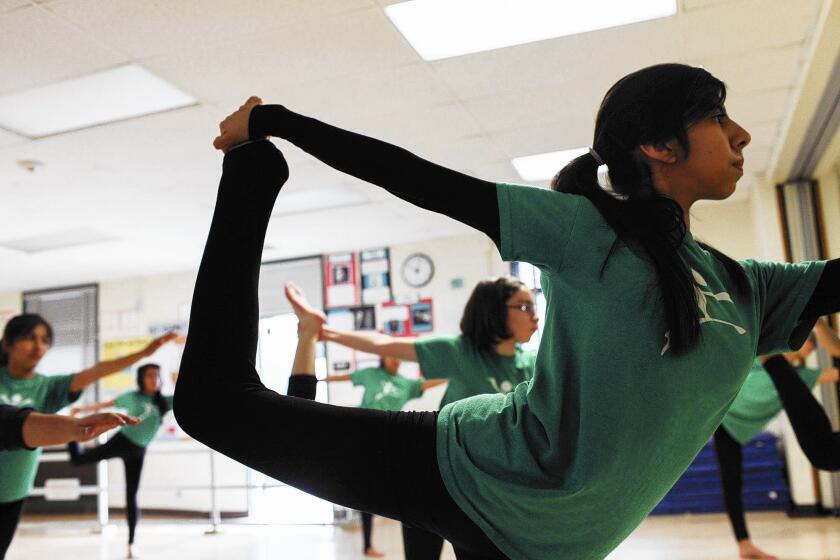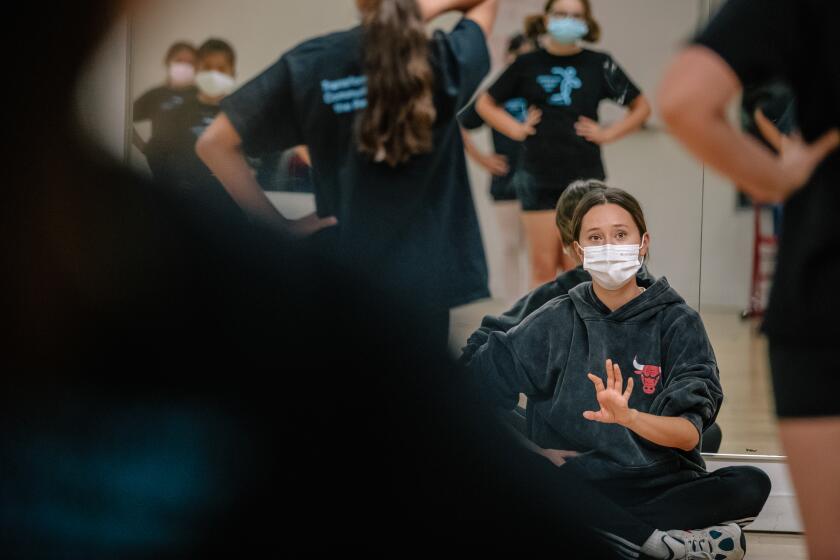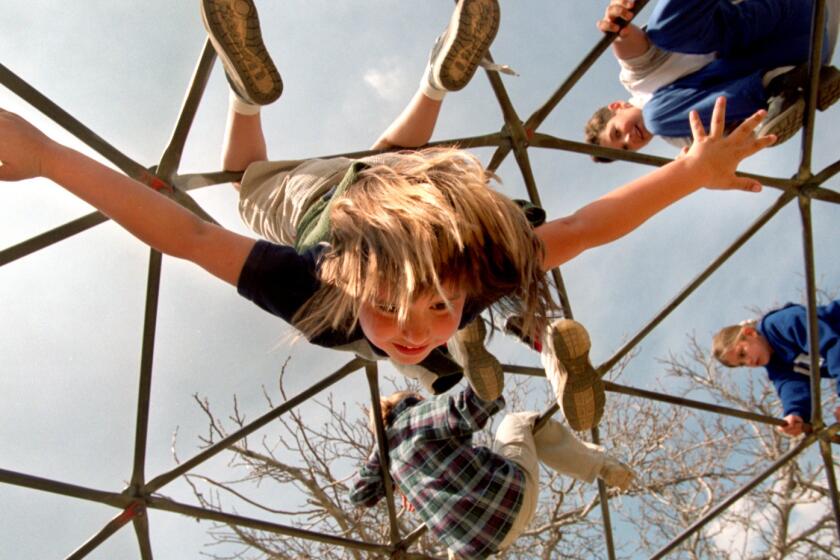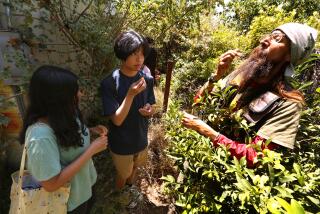25 years after 13-year-old dancer’s death, her legacy lives on at L.A. charter schools
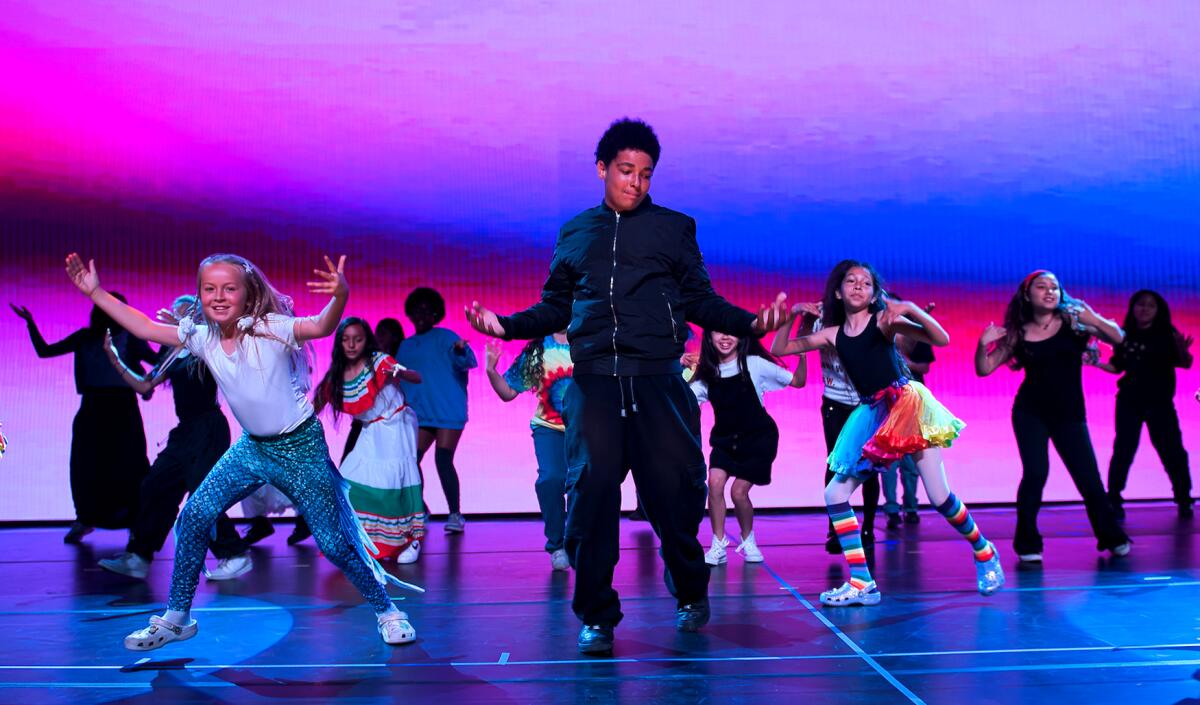
The Angelus Temple megachurch in Echo Park was the unlikely venue (and largest to date) for the Gabriella Charter Schools’ year-end dance recitals. Friends and family packed the 5,300-seat, three-story theater for two performances on a Saturday in June, which transported them from California’s redwood forests and Central Valley farms to the schools’ home of Los Angeles.
Sixth grader Annabelle Soriano took the stage as a voice-over in English and Spanish told the story — inspired by José Cruz González’s play “Two Donuts” — of a Guatemalan American girl who doesn’t see the beauty in her L.A. neighborhood. So, in her dreams, she embarks on an adventure through the Golden State in search of meaning. Students explore California through classic dance styles including tap, hip-hop and ballet mixed with moves popularized on TikTok and by the video game “Fortnite.”
Audiences lined Glendale Boulevard hours before the two performances. Gabriella Charter Schools Executive Director Rhonda Baldenegro said this is the norm for the schools’ annual recital — even though it’s only their second in-person performance since the COVID-19 pandemic.
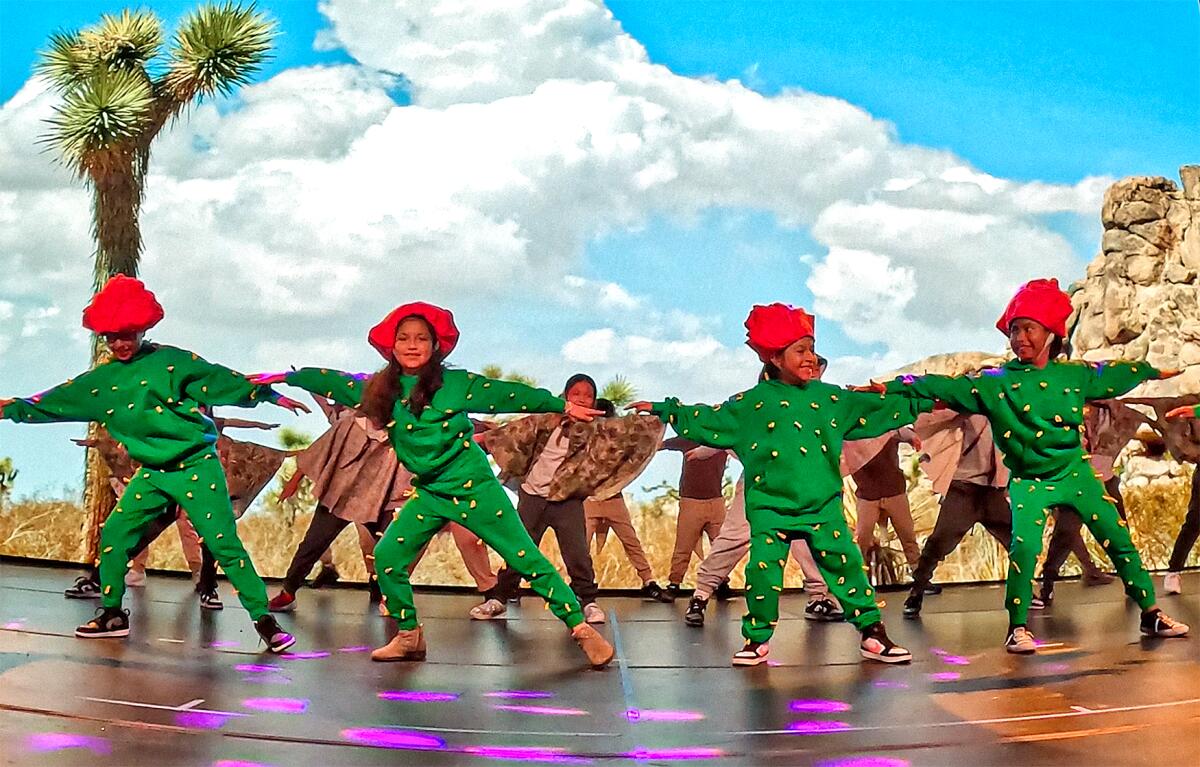
The event’s popularity is a testament to Liza Bercovici’s decades-long commitment to dance education. Bercovici, a former attorney, founded an after-school dance program for low-income communities in 1999 in honor of her 13-year-old daughter, Gabriella Axelrad, who was killed that year by a distracted driver while bicycling during a family vacation. Gabriella was a dancer and dreamed of becoming a teacher. In 2005, the program grew into a charter school for students from kindergarten through eighth grade. The Echo Park campus that is now its home opened in 2009 and spawned a second location in South L.A. in 2017. About 400 students are enrolled at each school.
Twenty-five years after Gabriella’s death, her legacy lives on.
“We serve a pretty impacted population and any experience that can be offered them that enhances their lives, to me, is just really, really important,” Bercovici said. “We as an organization have made this commitment to provide arts and dance at a very high level and a very frequent level, and that’s very atypical.”
Learning the dance of life, in memory of Gabriella
Baldenegro said GCS is one of the few public schools in the country to teach dance as a part of the curriculum multiple days a week. For many of GCS’ low-income students, it’s their sole opportunity for formal dance training.
Even after their big year-end recital, as summer vacation loomed, the kids at GCS kept dancing. For five students, the dancing will continue through the summer at the Theatrical Education Group’s Summer Arts Conservatory at Los Angeles County High School for the Arts. While enrollment costs more than $1,200, GCS students received full-ride scholarships.
GCS dance instructor Antavius Ellison was the catalyst in connecting the school and the program.
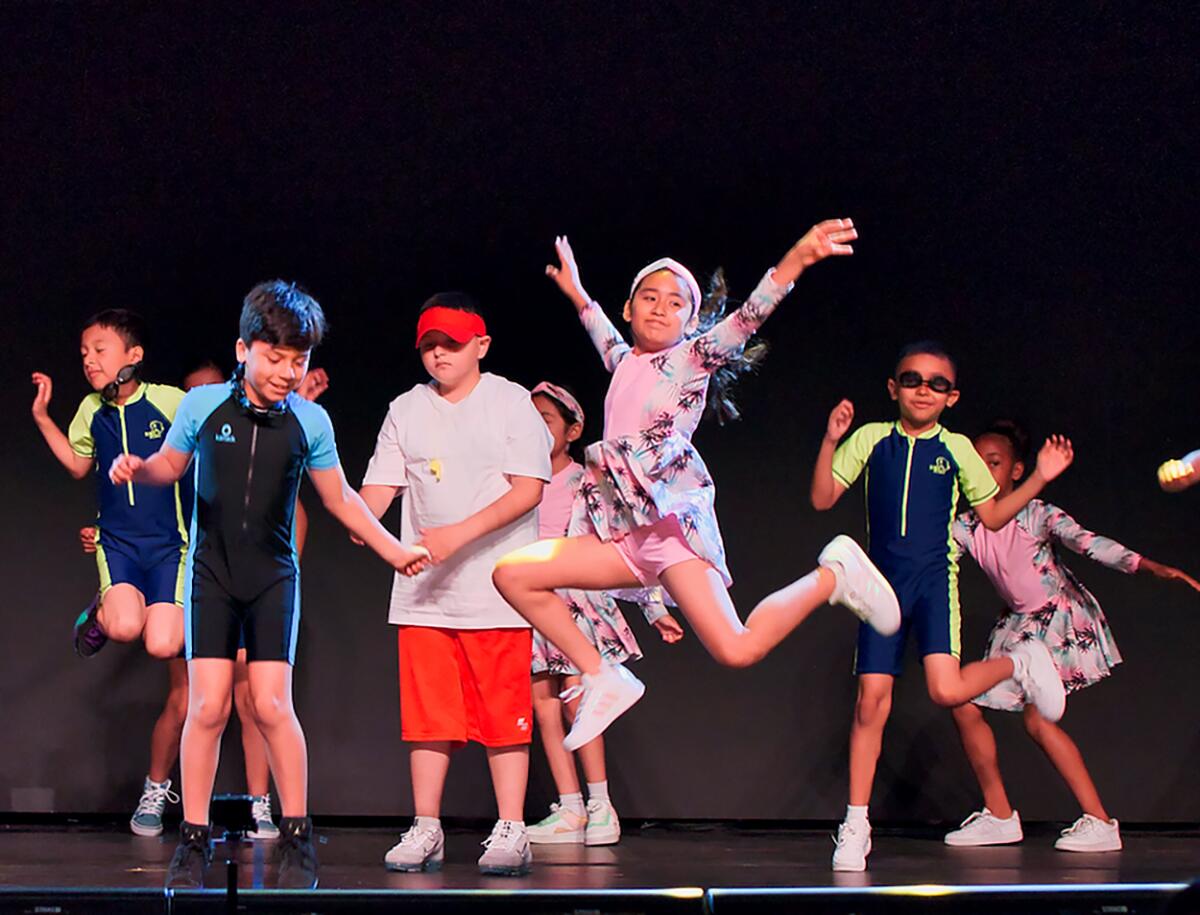
“The more I’m able to introduce [students] into those spaces now lets me feel like, ‘Hey, you’re doing your job. You didn’t have this growing up and now you’re able to pay it forward [in] a very hopeful way,’” said Ellison, a professional dancer who’s appeared in music videos for SZA and Hozier. “I feel like that’s one of my purposes for being at GCS right now. ... I take it as a sign from God that you are doing just what you need to do.”
One of the conservatory scholarship recipients is rising eighth grader Madison Pinon, whom Ellison personally chose for the scholarship. He calls her his “little assistant/mentee.”
“As soon as she found out, I’ve never seen that smile,” Madison’s mother, Berlin Pinon, said. “[It was] ear to ear that whole weekend.”
The young dancer joined GCS in fifth grade. She hadn’t taken classes since she was 8 years old. As her dance skills progressed, Madison began assisting Ellison in leading classes for younger students at the Echo Park campus.

The 13-year-old hopes to learn new styles of dance during the three-week program in July.
“In sixth grade, I discovered dance is something I can pursue in the future, something I can do for a living,” Madison said. “I feel like if I believe in the fact that I can — and in myself — I probably would be able to get there.”
Fifth-grader Nathan Sandoval is one of the scholarship recipients from the South L.A. campus. His mother, Nora Martinez, was “in shock” when she found out about the opportunity.
“I feel so blessed because they see my son has talent,” she said. “These are achievements that he’s doing himself because he loves [dance].”
Over 20 years, Everybody Dance has served thousands of low-income children and proven that good things can thrive, though they might need extra help.
Martinez said the 11-year-old was a born performer who finally shed his shyness at GCS.
“He always tells me before he goes onstage, ‘Mom, I’m doing this for you because you cheer for me and I know you’re going to like my dance,’” Martinez said.
Even as the COVID-19 pandemic forced schools into virtual learning, the dancing never stopped. During the spring 2020 semester, dance instructors recorded videos for students to watch, said Echo Park principal Stephanie Piazza. The school still put on its recital — although that year’s took the form of videos stitched together of the students dancing at home.
“In a lot of places, the pandemic stopped stuff that schools had been doing. And we just were like, ‘No, this matters. This is important. We’re going to figure out a way to do it,’” Piazza said. “Anytime I see a clip of the [2020] performance we did, it’s really emotional because we were all so lonely and sad, and we still found ways to connect like that.”
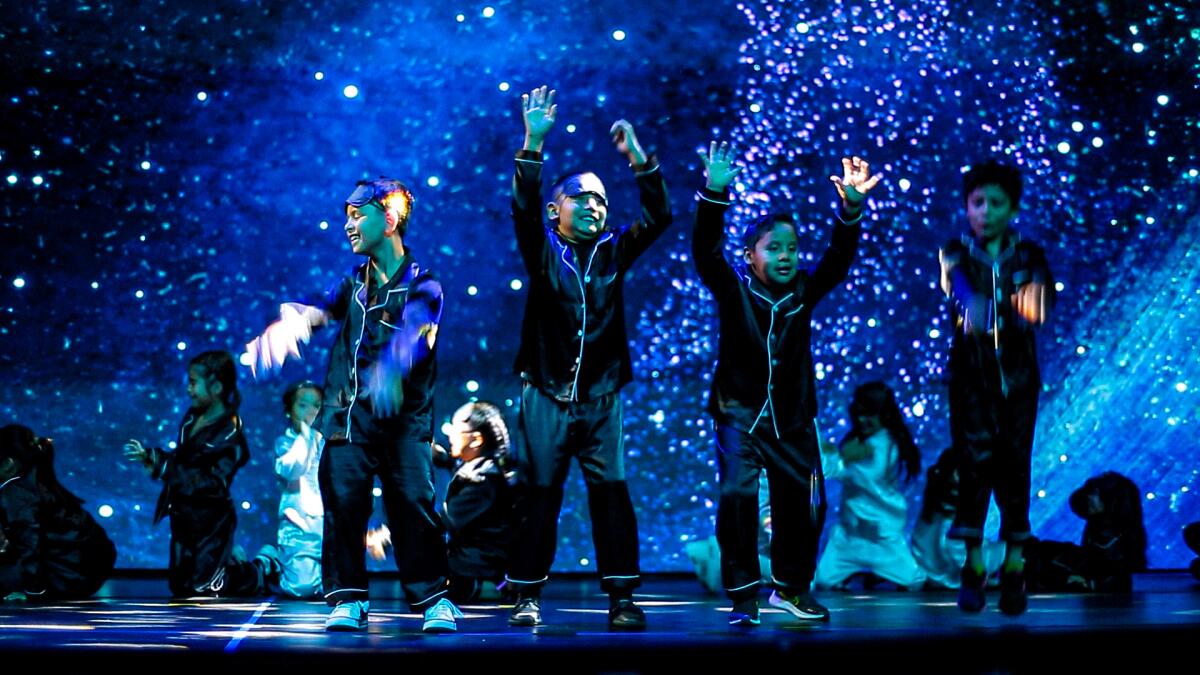
The schools’ commitment to dance earned them a California Pivotal Practice Award for innovation during the shutdown.
“Something I’m really proud of is that we never stopped doing any arts, even as budgets go everywhere all the time in California, that’s just because it’s our mission and vision that will never get touched,” Piazza said. “[Dance is] such a powerful way for kids to express themselves. ... It’s really amazing for kids, as young as 4 at our school, to have this other space where they can shine.”
Dance classes have been shown to help students’ physical and emotional well-being. In 2016, the Copenhagen Consensus Conference found that physical activity improves scholastic performance and brain function. Meanwhile, children’s arts education has been linked to improved grades and attendance.
“We really, truly believe in sort of the transformative power of dance, and how it can help kids learn better and just be more competent, poised individuals who have this great mind-body connection when it comes to learning,” Baldenegro said.
Walking through the Echo Park campus, everyone knows everyone else’s name. The common theme among students, family and faculty: a love for the community the schools have created.
“A lot of kids at my old school, they all kind of stick to their own group and they aren’t so happy,” Madison said. “But here, a lot of people are happy; they get really happy through dance.”
Attention parents: If you’d like to see your kids do better in school, have them close their books, set down their pencils and go outside to play.
The schools’ dance classes mix classic cardio exercises such as jumping jacks and high knees with choreography. The students move to popular tunes from artists such as Kali Uchis and Harry Styles. One dance to Drake’s “Controlla” was choreographed — and, for the first-grade class, led — by Madison.
Previously, Madison “stuck to choreography” that was familiar to her. She has since felt empowered to choreograph original dances in order to “express more” through her own movements, she said.
“I’ve seen a lot of growth within her, not only in her dancing skills — obviously with more practice that’s bound to happen — but just leadership skills and discipline. She really is committed and sets plans for everything,” Berlin said. “I can see she’s shaping up to be a great young woman.”
After the class concluded, two second-graders wanted to show off a dance they made up, complete with acrobatics.
“I couldn’t have paid them to have done that last semester,” Ellison said.
While the dance instructors at the schools are in charge of choreographing the recital, Ellison said he makes sure to incorporate his students’ moves.
“I want to give my students more agency to be able to create because I feel like that allows them to be more confident within themselves,” Ellison said. “They are taking up space in a very healthy way. ... A space is given for them to trust in their natural abilities, and to understand that movements and creativity will always look different, based off of the person, and there is no — to me — right or wrong way to move your body, to dance.”
More to Read
The biggest entertainment stories
Get our big stories about Hollywood, film, television, music, arts, culture and more right in your inbox as soon as they publish.
You may occasionally receive promotional content from the Los Angeles Times.
